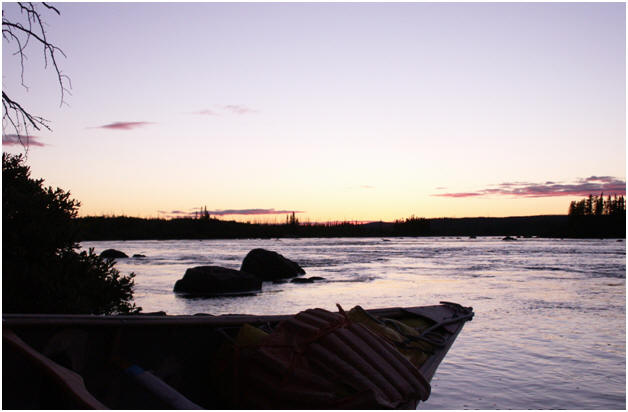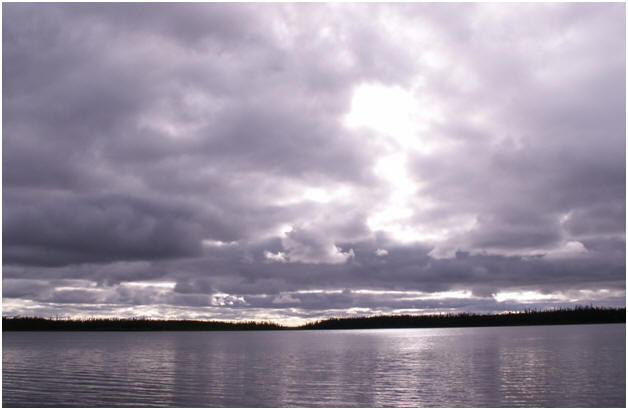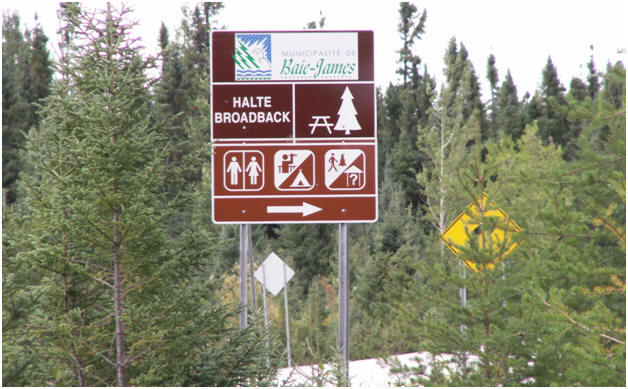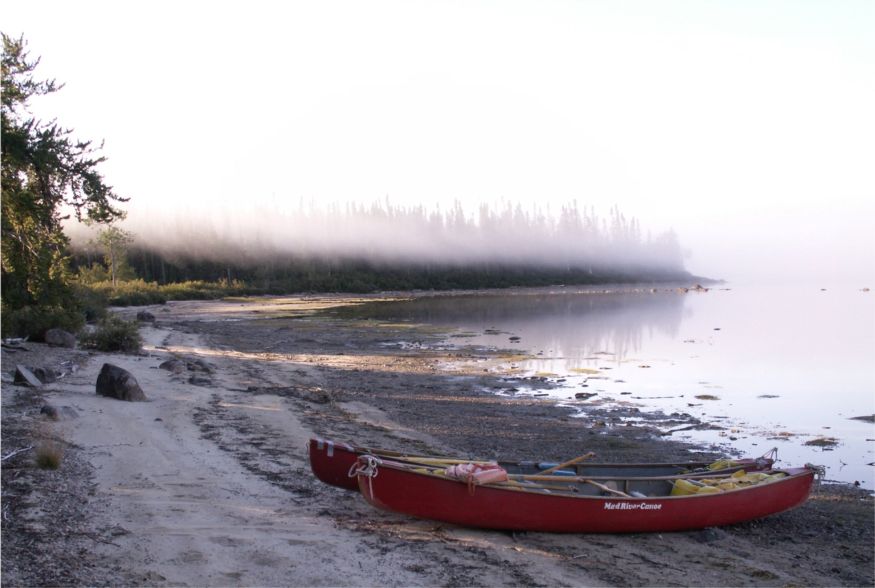|
Broadback River September 2007 |
||
|
Iíve taken a belated opportunity (three months delayed) to describe events of a wilderness canoe trip in Quebec Canada ending at Rupert Bay at the southern end of James Bay, which makes this a trip far into the northern hemisphere by any standard.
There I was engrossed in an endless parade of delays, and attempts to make misfortunes of business reverse in either nature or specifics, when on a Monday there was a call made via cell phone from 800-miles away. Curt, a close friend was making a second attempt to get me to take an overdue vacation. It looked like my attempts, reexaminations; redirected approaches all had not been productive. Curt was right. Seven years without a break; the timing was right for a vacation; a long one. Sometimes you just have to make yourself do something because life is not necessarily going to be there when you eventually decide to get around to living it. In the meantime, circumstances can lead you anywhere regardless of plans. On the spur of the moment I prepared for an extended stay in the wilderness far from civilization. It should normally take a minimum of a month to prepare for an excursion hundreds of miles from possible contact with anyone. I had a week. Fortunately I had been on trips of this nature before. Starting with previously used gear and additional clothing purchased in the interim, expecting to participate again, it seemed two things needed upgrading. Dry packs; a necessity to seal cloths or anything that needs to stay dry out of waters wet way. They keep things dry under difficult conditions. We were going to have to portage over a mile with heavy loads. After experimenting with the equipment I had, it was obvious I needed a serious backpack for the job. All I had was lightweight packs ill equipped for the task. The alternative would be multiple trips back and forth with light loads; an option of last resort in the wilderness. To prepare quickly, it was my good fortune Curt offered to pack all the needed food. Food alone could take a week to dry seal. Curt had also done all the research and gotten the topographic maps.
There is more to these trips than meets the eye. Thereís risk when no one can access assistance in a reasonable amount of time. Any injury of consequence could be life threatening. Even a seriously sprained ankle could be magnified into consequential melodrama. To make things worse there would be only two of us. This was to be a wilderness river canoe trip with whitewater from class one through four. The latter we would likely portage around. I say likely because Curt and I learned to canoe together. To put this in perspective, whitewater on a wilderness trip needs to be rated one level up from its normal classification for safety reasons. First there is the lack of rescue assistance, ever. Second there is the added weight of gear that makes maneuvering more cumbersome, less responsive, slower and more difficult. Emergency, last ditch recovery maneuvers just donít happen. We were upping the ante one more level by having only two people with two boats. Now you could say a class four rapid represents a class 6 (AKA: significant risk of life). What would we be thinking of running these rapids? First I said we would likely portage. Second, Curt and I for at least a decade or more were likely at the cutting edge for white water canoeists while learning our favorite sport. Being at the leading edge meant learning on our own, not as an experiment, but to train the mind to see and not make any serious mistakes in judgment. Whatís needed is the right mix of people at the edge; someone to push and someone entrenched in safety. Mistakes in whitewater can kill. Safety that says no inhibits new experiences. A good observer that puts whatís observed in balance encourages new experience. It also requires having a third person as backup, which we had in two or three different people over the years. Back to class four. I knew that we were capable of looking at a class four rapid and seeing what part(s) could be run to lower its level. We would be able to find what portion to walk, line or carry and what could be run in relative safety. We knew each other from those many years back and could trust each other to work it out together. If someone goes macho in whitewater, they are a serious risk to themselves and others. Neither of us has anything to prove. The class three rapids that should be upped one level making them a risk for many would be within our acquired ability even on a wilderness trip with only two of us or in an unlikely scenario we would know when they were not. With information Curt received from a Canadian wilderness paddling acquaintance it was determined 15 miles per day down river could be covered on average. The trip started on a large lake as expected. We began discovering, after days of lake padding in a wilderness environment of very large lakes and accompanying winds, there was so far no current to assist our progress from lake to large lake and then more lakes. By the end of 15 days we covered over 200 miles and less than 1% had noticeable current. Itís hard to describe. Imagine the effort of heavily loaded whitewater boats pushing hard against wind and even white-capped waves hour after hour, day after day after day. Only one of us suffered from this endurance effort. Curt, who would easily qualify for an adventure racing team routinely pulled away while wind was able to slow me. Considering there was a time when he was unable to do this, at least in un-laden canoes, and that I was in good physical shape, it reflects a paddling endurance effort severe in proportions. Most paddlers would not be able to keep up with me. An average team would have to work at it. The largest lake of the trip by far can be seen on a road map. Itís roughly in the shape of a U or perhaps a Y. The lakeís obstacle is distance which can be somewhat averted via portage overland across the peninsula that is formed between the arms of the "U". A portage averts a paddle of over 20 miles by a one way hiking distance of 2,200 meters; slightly over a mile. Of course with gear, two round trips are needed at minimum. Over 20 miles of potentially huge lake-wind; instead 2 miles carrying weight with 1 return mile hike seemed the better choice. We started out with almost all the gear. Curt, who has been in the wilderness so many times heís developed a third sense about many aspects, determined before we started that there was likely a better overland route than that provided on the topographic map's sketchy information from his Canadian source. This could easily be true, since portage trails this deep in the wild are only vaguely marked on maps and the actual ground routes can be so faint they are undetectable for stretches or permanently lost. We were off. My pack weight was approximately 75 to 80% of my body weight in anticipation of a slow pace for little over a mile and a desire to make only one return trip for just canoes. Curt carried two packs; one on his back and one across his chest. The pack's weight, unfortunately for me, was the easy part. Curt took it in stride. Consider a terrain damp enough to cause condensation every evening on the under side of a tent rain-fly before anyone entered the tent. Add uneven footsteps for each knee bend. Then step on sphagnum moss, a sponge like surface many layers deep to the tune of 6 to 12-inches. It makes every step an effort as resistance wears out muscles and requires high steps that quickly builds fatigue. Itís difficult walking without a pack. It makes one think of Mount Everest struggles when hiking through this stuff while seriously overloaded with weight. We were well into the distance when we decided the trail was not bearing off in the right direction. Now we had to bushwhack, no trail to follow toward the hidden far shore. It was no worse hiking, but it did hold an added danger. The sun became hidden behind an overcast sky. Now we had no reference to keep us on course. Without a reference or trail to follow itís easy to get turned around. Considering I could only hike 30 feet without stopping to lean on my paddle turned-walking-stick, and only 300 feet without having to take the pack off; getting turned around was doubly serious. Without a reference we could wonder off into oblivion; get permanently lost followed by death. We found ourselves approaching an immense open area we had been in before. We had turned around 180 degrees. Luckily I had packed a compass. As long as we followed a relatively straight course in the direction we knew the opposite shore would be, weíd get there, and then use the shoreline toward our intended destination. I pulled the compass out and corrected the declination for the Rupertís Bay area. We set forth again; Curt with compass leading and me struggling behind. At the first suggestion of approaching twilight, we looked for any possible space to put up a tent. There were just enough bushes etc. to turn finding suitable ground into a challenge. Sleeping on this wet surface unprotected would be hazardous at best. We had been hiking half a day to cover an intended mile-plus distance and had no idea how much further we had to go. Itís just as well we lacked the cook set. Lighting a fire wasnít likely and with soft moss there was no surface adequate to support the emergence backpack stove. An unconsumed lunch was good for dinner. With the tent up and some night rain, the next thought was daylight. Next morning became a quarter day to complete the hike out to the shore and find the end of the original portage trail after perhaps an added mile hike along a bolder strewn shoreline. One misstep on a jumble of slippery surfaces could have been serious. Under an overcast sky came a new decision. Do we portage the canoes as planned or take some gear back and paddle around the peninsula? We carried gear back for the 20 plus mile paddle. Struggling with canoes across this terrain would be worse than a wind swept lake. The hike back, even lightly laden was a difficult high stepping effort over and into the moss. The trail itself was so tenuous it could only be found via rare yellow ribbon markers left by a previous group (Curtís Canadian contact).
We made it back to our boats and headed down the shoreline. Iím not sure how far we got, but we kept close to the shore to gain minimal relief from the on shore wind. So far during this day we had hiked out from somewhere mid peninsula, traversed a difficult bolder shoreline perhaps a mile, snacked, repacked some emergency food and gear for the likelihood we would not paddle 20-plus-miles in the remaining day, and found our way back across an almost unmarked trail to where our canoes awaited. Somewhere in the fading light we found a rock ledge we could haul out on to set camp for the night early enough to find squaw-wood for kindling plus collected dead standing branches for a fire to cook over. We hadnít brought the tent, but we had just enough lightweight tarp to somewhat shelter two canoes into which we could attempt to squeeze for some sleep. Itís not easy to get under canoe thwarts but we managed. In the middle of the night it began raining. Our makeshift canopy was perhaps 98% effective, but small drips can fill a barrel or a boat given time. Both Curt and I awoke in the dark, aware of a gaining puddle effect in our canoes, each of us in our silent distress. Finally one of us moved sufficiently for the other boat occupant to hear. After a short conversation, we determined we were as likely to get wet getting up and moving on in the dark as attempting to avoid growing boat puddles. The drizzle that tapped on our canopy slowed as each of us figured out how to get boots back on in the cramped quarters under the sloping wet tarp while staying centered on our thin ground pads; the only things keeping us out of pooled water in each boat. At least there seemed to be no wind. By the time we were up in our rain gear, it stopped drizzling. We packed, did a flashlight sweep to assure we had everything and headed off during what appeared to be a possible glow of morning light atop a short stretch of distant horizon that otherwise disappeared into a starless night. Itís amazing what you can see in the blackness if you listen and thereís a trace of light. Still calm, no rain, daylight grew. Wind cut us the first break I could remember during the trip. Overcast, it was almost dead calm. Perhaps it had taken us a cumulative time of one day to make a single round trip hiking overland; to accomplish what should have amounted to roughly 2 1/2-miles. Now we had perhaps 15-remaining-miles to paddle back to our packs. Whatever wind, wave and weather might fill the remainder of the day would have to be overcome. With a calm lake we made great distance in short order. Working hard we arrived at the end of the peninsula and paddled across its tip still with minimal breeze. We had done well so far, making 8 plus miles in much less time than during any previous day. If our luck held out, we would be back to the rest of our gear in minimal hours. Funny about the wind; though more aggravating while in your face or from the side; unless it is directly behind, in a canoe itís no less painful when at your back. You struggle to maintain direction. And here it comes, blowing strong. We could follow a curved shoreline for safety or cut across open water for much more than a mile to save time. It was a tailwind and likely to continue from behind, the same general direction observed during the previous two days. Risk versus opportunity; we could put in the effort to follow the curvature of the much greater distance shoreline, perhaps doubling the paddling time while somewhat sheltered by the shore induced calmer waves or tough it out far into the lake. Of course itís not that simple. Exposed to not just higher winds off shore, waves are usually higher, more likely to be curing over and should wind speed increase or change direction to somewhat off shore, we could easily be exposed to shipping water while not being able to bail because of attending loss in boat control when not paddling. We could be blown further away from shore already a half mile off. Reaching the far distant shore for safety would be miles away; further than the possibly two miles to the next shore-point we would be shooting for. With the wind significantly from behind we headed straight for the distant shore-point. We were perhaps past half way when a light rain started. Not to worry, just figure out how to close up rain gear mid strokes so direction and control remain. Then it started to downpour, a new threat. Even a tub will fill if a stopper is place in the drain. Our canoes could slowly or quickly fill causing lowered speed and more sluggish response due to gained weight; increasing the risk of shipping additional water and sinking. If soaked far from shore, hypothermia induced drowning wouldn't take long. We altered course, not that it would make much difference this far from shore. We angled midway between heading straight for shore and the original target. Still working hard to maintain direction in the wind and waves, it now required un-securing a bailer and timing a scoop of bailing-water mid canoe stroke which decreases the effectiveness of paddling due to fewer strokes per minute. Itís also more tiring, but the best option. It was now raining so hard it initiated paddling with face tilted downward to keep rain from eyes protected only by the suggested brim of a rain jacket. Take the shortest route was beginning to feel like a bad decision. It would be a long push to get near shore. The key to getting through this is staying focused on all of the tasks and maintaining the strength of strokes needed to move forward. As we neared perhaps a quarter mile off shore, the rain eased up. We changed angle again, aiming more toward our original target. It was still blowing hard, but our goal was getting closer. Itís an interesting thought to be so focused on an end goal, reaching our equipment on a still distant shore, that the interim issues become less important. We didnít know how far we still had to go and didnít know if we would have additional long stretches of open water to consider crossing, but the shore was getting closer and we were making progress. Thatís what mattered at the moment. Rounding the point of land, our target for well over an hour, brought the next possible mist shrouded target into view. How long to the rest of our gear isnít as important as remaining daylight. Itís taken two and a half days to cover the last 20 plus miles of lake and we have many more to go one stroke at a time. After two weeks paddling, having arrived at the only exit opportunity other than put-in or take-out, we assessed continuing. We had lost just enough time padding open water instead of expected river current; we now had just enough potential time to reach the take-out on schedule. Considering the attendant open water paddling difficulty, we had made remarkable time. For the last quarter mile we finally found a river. It actually had class three rapids, not just some current. Looking at our topographic maps, it looked like we would be in for much more. This would present a wonderful river paddling opportunity. One problem; what if we faced wind? After reaching the riverís end, how long would it take to negotiate open water in Rupert Bay? How long would it take to paddle up the Rupert River to the Cree village of Waskaganish where our car was parked? With no leeway time we would be pushed to keep up high mileage for another week. I opted to end where we were. Having pushed my body to its limit for two weeks, the potential for fun versus risk of pressing mileage with loaded canoes in unknown rapids on a wide river with possibly high wind wasnít worth the gamble.
This wilderness trip expressed some challenges that could await anyone leaving the comforts of modern industrialized society. Itís also a reminder how much can be appreciated being middle class in America at the turn of the twenty first century. Curt and I drove back to New Jersey. I visited friends for a week before heading back to Georgia, warm water on tap in a temperature controlled house, food in the frig and accomplishments gained in the wilderness.
|
||




